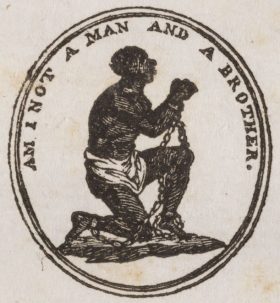The world's first antislavery society was founded in 1775 by Quakers in Philadelphia, the year the Revolution began. By 1788, at least thirteen of these clubs were known to exist in the American colonies. Some Northern states banned slavery outright, and some provided for the gradual end of slavery. At any rate, the climate of the Revolution made the institution unacceptable in the minds of many Northerners, who did not rely on forced labor as part of the economic system. Northerners did not, however, go as far as to grant equal rights to freed blacks. Nonetheless, this ignited the philosophical debate that would be waged throughout the next century.
Many slaves achieved their freedom during the Revolution without formal emancipation. The British army, eager to destroy the colonial economy, freed many slaves as they moved through the American South. Many slaves in the North were granted their freedom if they agreed to fight for the American cause. Although a clear majority of African Americans remained in bondage, the growth of free black communities in America was greatly fostered by the War for American Independence. Revolutionary sentiments led to the banning of the importation of slaves in 1807.
Slavery did not end overnight in America. Before any meaningful reform could happen, people needed to recognize that the economic benefit was vastly overshadowed by the overwhelming repugnance, immorality, and inhumanity of slavery.
As the cotton industry grew and slavery became more and more entrenched across the American South, opposition to it also grew.
The first widely accepted solution to the slavery question in the 1820s was colonization. In effect, supporters of colonization wanted to transplant the slave population back to Africa. Their philosophy was simple: slaves were brought to America involuntarily. Why not give them a chance to enjoy life as though such a forced migration had never taken place? Funds were raised to transport freed African-Americans across the Atlantic in the opposite direction. The nation of Liberia was created as a haven for former American slaves.
But most African-Americans opposed this practice. The vast majority had never set foot on African soil. Many African-Americans rightly believed that they had helped build this country and deserved to live as free citizens of America. By the end of the decade, a full-blown Abolitionist movement was born.
These new Abolitionists were different from their forebears. They were more radical than members of the early antislavery societies. Past Abolitionists had called for a gradual end to slavery. They supported compensation to owners of slaves for their loss of property. They raised money for the purchase of slaves to grant freedom to selected individuals.
The new Abolitionists thought differently. They saw slavery as a blight on America that must be brought to an end immediately and without compensation to owners. They sent petitions to Congress and the states, campaigned for office, and flooded the South with inflammatory literature.
Needless to say, they raised eyebrows throughout the North and the South. Soon, the battle lines were drawn. President Andrew Jackson banned the post office from delivering Abolitionist literature in the south. A "gag rule" was passed on the floor of the House of Representatives forbidding the discussion of bills that restricted slavery. Abolitionists were physically attacked because of their outspoken anti-slavery views. While northern churches rallied to the Abolitionist cause, the churches of the South used the Bible to defend slavery.
Abolitionists were always a minority, even on the eve of the Civil War. Their dogged determination to end human bondage was a struggle that persisted for decades. While mostly peaceful at first, abolitionists and their opponents began to trade violence as each side became more and more firmly rooted in its beliefs. Another seed of sectional conflict had been deeply planted in America's psyche.





